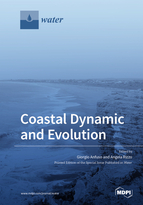Coastal Dynamic and Evolution
A special issue of Water (ISSN 2073-4441). This special issue belongs to the section "Oceans and Coastal Zones".
Deadline for manuscript submissions: closed (31 March 2020) | Viewed by 72053
Special Issue Editors
Interests: coastal geomorphology; coastal short-term evolution; disturbance depth; seasonal evolution; historical changes
Special Issues, Collections and Topics in MDPI journals
Interests: coastal geomorphology; coastal short-term evolution; historical changes; sea level rise; climate change
Special Issues, Collections and Topics in MDPI journals
Special Issue Information
Dear Colleagues,
This Special Issue is devoted to geomorphological studies on coastal dynamic and evolution. Results of field studies, observations, and surveys on morphological changes of the shoreline and/or dune system at different time scales, from hours, days, to months and years, as well as historical coastal evolution investigations, carried out by means of aerial photos and/or satellite images, and research results concerning coastal changes at scale of decades/centuries, linked to past and future sea level variations and/or land tectonic movements, are welcome. Study cases have to investigate relatively large spatial areas, i.e., coastal sectors of tens of kilometers. Last, investigations on coastal wave climates and the characterization of marine storms in a context of climate change scenarios are also of interest.
Prof. Dr. Giorgio Anfuso
Dr. Angela Rizzo
Guest Editors
Manuscript Submission Information
Manuscripts should be submitted online at www.mdpi.com by registering and logging in to this website. Once you are registered, click here to go to the submission form. Manuscripts can be submitted until the deadline. All submissions that pass pre-check are peer-reviewed. Accepted papers will be published continuously in the journal (as soon as accepted) and will be listed together on the special issue website. Research articles, review articles as well as short communications are invited. For planned papers, a title and short abstract (about 100 words) can be sent to the Editorial Office for announcement on this website.
Submitted manuscripts should not have been published previously, nor be under consideration for publication elsewhere (except conference proceedings papers). All manuscripts are thoroughly refereed through a single-blind peer-review process. A guide for authors and other relevant information for submission of manuscripts is available on the Instructions for Authors page. Water is an international peer-reviewed open access semimonthly journal published by MDPI.
Please visit the Instructions for Authors page before submitting a manuscript. The Article Processing Charge (APC) for publication in this open access journal is 2600 CHF (Swiss Francs). Submitted papers should be well formatted and use good English. Authors may use MDPI's English editing service prior to publication or during author revisions.
Keywords
- beach surveys
- disturbance depth
- aerial photographs
- satellite images
- sea level rise
- wave climate
- marine storms







